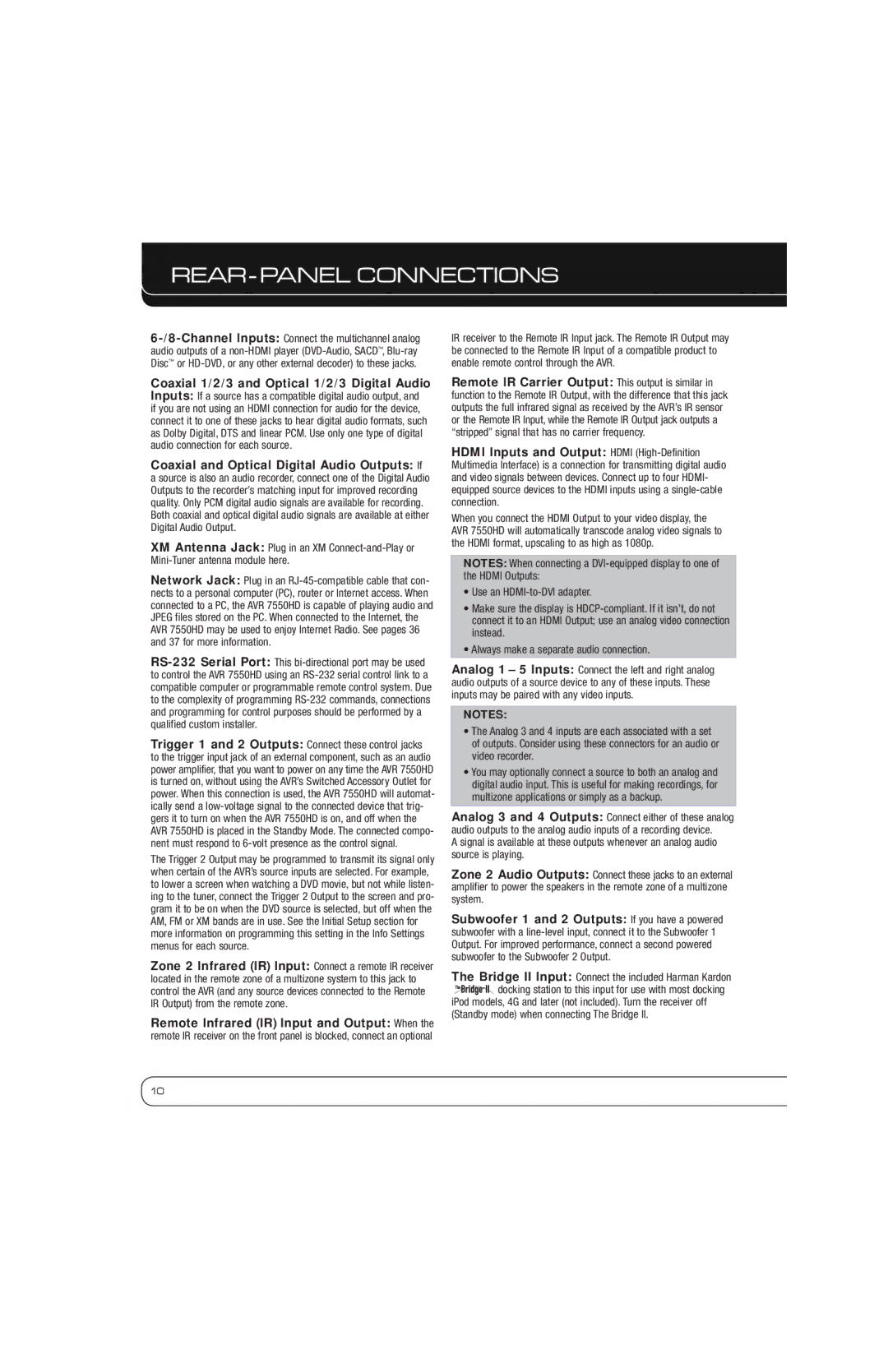
REAR-PANEL CONNECTIONS
Coaxial 1/2/3 and Optical 1/2/3 Digital Audio Inputs: If a source has a compatible digital audio output, and if you are not using an HDMI connection for audio for the device, connect it to one of these jacks to hear digital audio formats, such as Dolby Digital, DTS and linear PCM. Use only one type of digital audio connection for each source.
Coaxial and Optical Digital Audio Outputs: If a source is also an audio recorder, connect one of the Digital Audio Outputs to the recorder’s matching input for improved recording quality. Only PCM digital audio signals are available for recording. Both coaxial and optical digital audio signals are available at either Digital Audio Output.
XM Antenna Jack: Plug in an XM
Network Jack: Plug in an
Trigger 1 and 2 Outputs: Connect these control jacks to the trigger input jack of an external component, such as an audio power amplifier, that you want to power on any time the AVR 7550HD is turned on, without using the AVR’s Switched Accessory Outlet for power. When this connection is used, the AVR 7550HD will automat- ically send a
The Trigger 2 Output may be programmed to transmit its signal only when certain of the AVR’s source inputs are selected. For example, to lower a screen when watching a DVD movie, but not while listen- ing to the tuner, connect the Trigger 2 Output to the screen and pro- gram it to be on when the DVD source is selected, but off when the AM, FM or XM bands are in use. See the Initial Setup section for more information on programming this setting in the Info Settings menus for each source.
Zone 2 Infrared (IR) Input: Connect a remote IR receiver located in the remote zone of a multizone system to this jack to control the AVR (and any source devices connected to the Remote IR Output) from the remote zone.
Remote Infrared (IR) Input and Output: When the remote IR receiver on the front panel is blocked, connect an optional
IR receiver to the Remote IR Input jack. The Remote IR Output may be connected to the Remote IR Input of a compatible product to enable remote control through the AVR.
Remote IR Carrier Output: This output is similar in function to the Remote IR Output, with the difference that this jack outputs the full infrared signal as received by the AVR’s IR sensor or the Remote IR Input, while the Remote IR Output jack outputs a “stripped” signal that has no carrier frequency.
HDMI Inputs and Output: HDMI
When you connect the HDMI Output to your video display, the AVR 7550HD will automatically transcode analog video signals to the HDMI format, upscaling to as high as 1080p.
NOTES: When connecting a
•Use an
•Make sure the display is
•Always make a separate audio connection.
Analog 1 – 5 Inputs: Connect the left and right analog audio outputs of a source device to any of these inputs. These inputs may be paired with any video inputs.
NOTES:
•The Analog 3 and 4 inputs are each associated with a set of outputs. Consider using these connectors for an audio or video recorder.
•You may optionally connect a source to both an analog and digital audio input. This is useful for making recordings, for multizone applications or simply as a backup.
Analog 3 and 4 Outputs: Connect either of these analog audio outputs to the analog audio inputs of a recording device.
A signal is available at these outputs whenever an analog audio source is playing.
Zone 2 Audio Outputs: Connect these jacks to an external amplifier to power the speakers in the remote zone of a multizone system.
Subwoofer 1 and 2 Outputs: If you have a powered subwoofer with a
The Bridge II Input: Connect the included Harman Kardon ![]() docking station to this input for use with most docking
docking station to this input for use with most docking
iPod models, 4G and later (not included). Turn the receiver off (Standby mode) when connecting The Bridge II.
10
